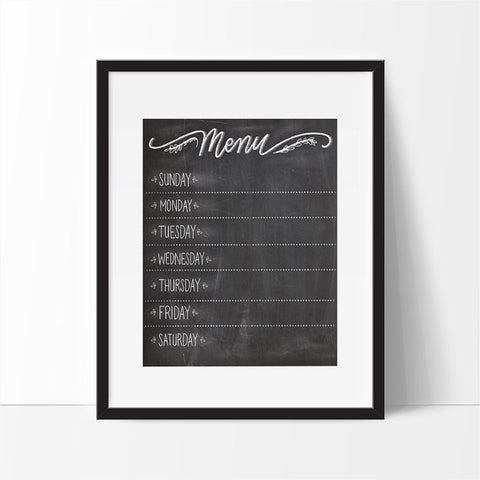The Benefits of Making A Weekly Menu Plan
You will save money. When you make a menu plan, you also make a grocery list for the week. Going to the store once results in fewer temptations and impulse purchases. As you grow more confident, you’ll be able to plan your menu around the store’s sales too.
You will reduce stress. If your family eats three meals a day, seven days a week, you have to come up with meal ideas twenty-one times a week. If your family as picky as mine, that means you also have twenty-one small arguments. A weekly menu plan lets you schedule meals everyone will happily eat.
You’ll save time. Making just one trip to the store is just the beginning. By properly planning your weekly menu, you’ll be able to turn leftovers into entirely new creations, saving you an enormous amount of time.
You’ll eat better. Once you’re not making decisions at the last minute, you’ll be able to think about whether your family is eating an appropriately varied diet. Are they getting fruits and vegetables with each meal? What about whole grains? Making these part of your weekly menu plan improves nutrition, too.
How to Make a Weekly Menu Plan
Rather than jumping into planning every meal for an entire week, start by choosing one meal to focus on for the first week or two. Does your family eat breakfast together in the morning? Start by planning a week of breakfasts they’ll love? Is dinner more your thing? Make the other two meals each day grab-and-go things, and put your effort into crafting a dinner menu for the week.
Step One: Create a list of trusted recipes. Now isn’t the time to test a bunch of new recipes you saw on Pinterest. Sit down with your tried-and-true family recipes and come up with seven you know your family already loves. It’s a good idea to ask for their input, too. Doing so gives them ownership of the menu and they’re less likely to complain when you serve something they’ve requested.
Step Two: Sort the recipes by protein. Even avid chicken fans get tired of eating it for dinner every night. If your list of trusty recipes is all chicken-based, head back to your recipe file and mix things up! For my family, I try to serve two chicken meals, 2 meatless meals, 2 fish meals, and one beef meal per week. Then I alternate the proteins, so we aren’t eating the same one on two nights in a row.
Step Three: Make Your lists. Once you know which meals you’ll be serving, write them down on one side of a sheet of paper. On the other side, make a list of all the ingredients required. Don’t forget to list the spices and condiments, too. Consolidate as you work, so instead of having “1 cup brown rice” on your list three different times you wind up with “brown rice: 3 cups.” This is your Master List for the week. (More on how to use that in a bit.)
Step Four: Figure out what you already have. Look through your cupboards, refrigerator, freezer, and pantry to find out what ingredients you don’t need to buy. If you’re short on something or don’t have it at all, put it on your grocery list. Don’t be afraid to make substitutions, either. For example, if a recipe for 1 lb. ground beef, but you’ve got 1 lb. ground turkey in the freezer, go with what you have!
Step Five: Post it! Hang your weekly menu plan where family members can see it. Next time they ask what’s for dinner you can point to the list. This isn’t just about saving your voice: once they see you’ve got the week’s meals planned, and that none of them include the drive-through, they’ll stop asking for it as often. You might even find they start looking forward to Meatloaf on Friday or Pad Thai on Tuesday.
Step Six: Just do it. Get your shopping done and start serving meals based on your weekly menu plan. Make notes as needed about things that didn’t work well and what did. Maybe baking a quiche for breakfast on a school day wasn’t such a great idea, but your family loved the French Toast you served Saturday morning. Next time, perhaps you could make a double batch of French Toast and freeze the extras to reheat for school mornings? Or make the quiche over the weekend to heat-and-serve on weekdays?
Step Seven: Do it again next week. Put your Master List for Week One away. Now, go through Steps 1-5 for Week Two, taking just as much care to create a Master List and adding notes about your trials and successes.
Step Eight: Rotate them. Once you have two Master Lists of meals and ingredients, rotate them! Your kids won’t remember they had oatmeal with raisins and dried cranberries precisely 14 days ago, so why go through the effort of coming up with all-new, unique menu plans week after week?
Advanced Menu-Planning Tips
When you’ve perfected two or more weeks of menus, you’re ready for advanced planning.
Swap in ONE new recipe per week. Found a great soup on Pinterest you’d like to try? Swap it for one of the trusty meals on a Master List, then repeat steps 1 through 6. Now you’ve created a third Master List. Sweet!
Double up. Are chicken breasts on sale this week? Buy extras and double your recipes throughout the week. Stash the second batch in the freezer. Next time you rotate through that week’s menu you’ll be able to defrost, reheat, and serve.
Cook once, eat twice. Speed up dinner prep by cooking things you can use in two separate dinners. Roast a chicken for dinner one night, for instance, then use what’s left to make chicken noodle soup. Make a large batch of quinoa to serve as a side dish one evening, then add chopped cucumbers, tomatoes, olive oil, and red wine vinegar to turn it into a salad. This is a fantastic way to save time.
Shop the seasons. Buying what’s in season is a great way to get the most out of your grocery dollars. Once you’ve made and used your Master Lists for a few months, you’ll probably find yourself ready to move on to other meals, anyway. That doesn’t mean you should toss your lists — you’ve put a lot of work into them! Store them in your household notebook or recipe file for next year, and create a new set of Master Lists for the new season. Do that four times in a row and you’ve got an entire year planned. Talk about saving a ton of time!
From- Housewife How-To’s


